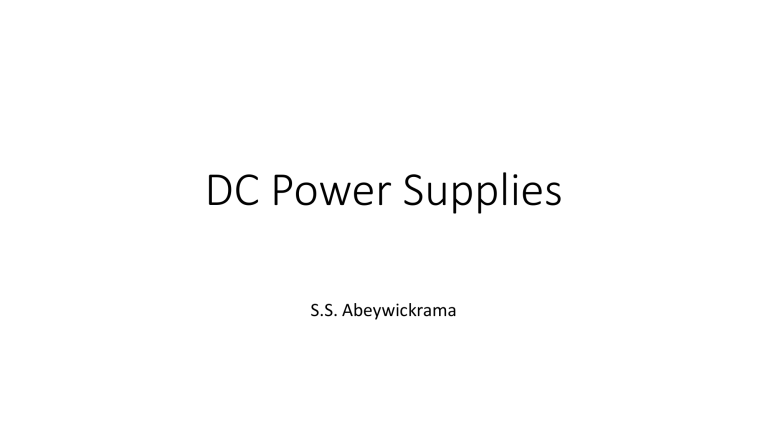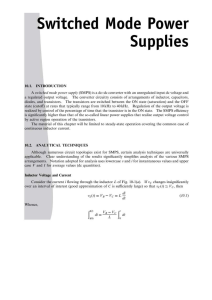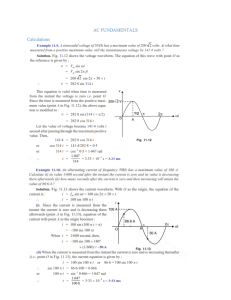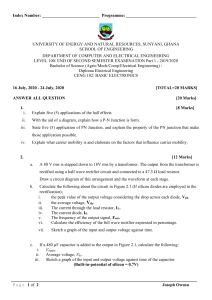DC Power Supplies: Transformers, Rectifiers, Filters, Regulators
advertisement

DC Power Supplies S.S. Abeywickrama DC power supplies Why DC power sources ? Most electronic devices and circuits require a DC source for their operations. What can perform as a DC Source ? 1. Electrical cells 2. Batteries 3. conventional DC power supplies Why DC Power supplies? Most Convenient Economical No replacements DC power supply AC Mains Step -Down Transformer Rectifier V Voltage regulator Filter V V V V t t LOAD t t V t Block Diagram of the Dc power supply t Step-down Transformer Step-down transformer is used to reduce the amplitude of the AC voltage and it provides following advantages • works as an isolator between AC source and rectifier circuit • Reduces the chance of getting electric shocks Where: VP - is the Primary Voltage VS - is the Secondary Voltage NP - is the Number of Primary Windings NS - is the Number of Secondary Windings Step-Down Transformer Center-tapped Transformer This type of transformers are used to construct two output signals with same amplitude and 1800 phase difference Rectifier A Rectifier is a circuit that can convert the AC signals into pulsating DC Signals. Two types of rectifiers are available 1. Half-wave rectifier 2. Full-wave rectifier pulsating DC Signals Half-wave rectifier Half-wave rectifier circuit Transformer: VS –instantaneous voltage of the secondary winding VS(max) –peak voltage of the secondary winding Load: VL –instantaneous voltage of the load resistor IL –instantaneous current of the load resistor IL(max) –maximum value of the load current VL(max) –maximum value of the voltage across the load resistor VL (rms) – rms value of the entire voltage across the load resistor VL VL (DC) (AC) –DC value of the voltage across the load resistor –rms value of the AC components of the voltage across the load resistor Half-wave rectifier circuit Ripple factor Ripple factor, = 𝑟𝑚𝑠 𝑣𝑎𝑙𝑢𝑒 𝑜𝑓 𝐴𝐶 𝑐𝑜𝑚𝑝𝑜𝑛𝑒𝑛𝑡𝑠 𝑜𝑓 𝑡ℎ𝑒 𝑙𝑜𝑎𝑑 𝑣𝑜𝑙𝑡𝑎𝑔𝑒 𝐷𝐶 𝑣𝑎𝑙𝑢𝑒 𝑜𝑓 𝑡ℎ𝑒 𝑙𝑜𝑎𝑑 𝑣𝑜𝑙𝑡𝑎𝑔𝑒 VL (AC) = VL (DC) for a half-wave rectifier, =1.21 Efficiency Efficiency , = 𝐷𝐶 𝑝𝑜𝑤𝑒𝑟 𝑑𝑒𝑙𝑖𝑣𝑒𝑟𝑒𝑑 𝑡𝑜 𝑡ℎ𝑒 𝑙𝑜𝑎𝑑 𝑇𝑜𝑡𝑎𝑙 𝑝𝑜𝑤𝑒𝑟 𝑑𝑖𝑠𝑠𝑎𝑝𝑎𝑡𝑖𝑜𝑛 IL (DC)2RL = × 100% 2 IL (rms) (RL+RD+Rs) PL (DC) × 100% = × 100% PL (Total) Half-wave rectifier circuit Peak inverse voltage (PIV): It is the maximum voltage occurs across the rectifying diode in the reverse direction. For a half-wave rectifier, diode is reverse biased during the negative half-cycle PIV equals the maximum voltage across the secondary voltage. Full-wave rectifier with center-tapped transformer Full-wave rectifier with center-tapped transformer Transformer: VS –instantaneous voltage of the secondary winding VS(max) –peak voltage of the secondary winding Load: VL –instantaneous voltage of the load resistor IL –instantaneous current of the load resistor IL(max) –maximum value of the load current VL(max) –maximum value of the voltage across the load resistor VL (rms) – rms value of the entire voltage across the load resistor VL (DC) –DC value of the voltage across the load resistor VL (AC) –rms value of the AC components of the voltage across the load resistor Full-wave rectifier with center-tapped transformer Ripple factor Ripple factor, = 𝑟𝑚𝑠 𝑣𝑎𝑙𝑢𝑒 𝑜𝑓 𝐴𝐶 𝑐𝑜𝑚𝑝𝑜𝑛𝑒𝑛𝑡𝑠 𝑜𝑓 𝑡ℎ𝑒 𝑙𝑜𝑎𝑑 𝑣𝑜𝑙𝑡𝑎𝑔𝑒 𝐷𝐶 𝑣𝑎𝑙𝑢𝑒 𝑜𝑓 𝑡ℎ𝑒 𝑙𝑜𝑎𝑑 𝑣𝑜𝑙𝑡𝑎𝑔𝑒 VL (AC) = VL (DC) for a half-wave rectifier, =0.482 Efficiency Efficiency , = 𝐷𝐶 𝑝𝑜𝑤𝑒𝑟 𝑑𝑒𝑙𝑖𝑣𝑒𝑟𝑒𝑑 𝑡𝑜 𝑡ℎ𝑒 𝑙𝑜𝑎𝑑 𝑇𝑜𝑡𝑎𝑙 𝑝𝑜𝑤𝑒𝑟 𝑑𝑖𝑠𝑠𝑎𝑝𝑎𝑡𝑖𝑜𝑛 PL (DC) × 100% = × 100% PL (Total) IL (DC)2RL = × 100% 2 IL (rms) (RL+rD+Rs) Here, Rs is considered as resistance of one secondary winding. Full-wave rectifier with center-tapped transformer Peak inverse voltage (PIV): For a full-wave rectifier with center-tapped transformer, PIV = 2VS(max) (VS(max) is the maximum voltage across one of its secondary windings) Full-wave bridge rectifier Full-wave bridge rectifier full-wave bridge rectifier Transformer: VS –instantaneous voltage of the secondary winding VS(max) –peak voltage of the secondary winding Load: VL –instantaneous voltage of the load resistor IL –instantaneous current of the load resistor IL(max) –maximum value of the load current VL(max) –maximum value of the voltage across the load resistor VL (rms) – rms value of the entire voltage across the load resistor VL VL (DC) (AC) –DC value of the voltage across the load resistor –rms value of the AC components of the voltage across the load resistor full-wave bridge rectifier Ripple factor Ripple factor, = 𝑟𝑚𝑠 𝑣𝑎𝑙𝑢𝑒 𝑜𝑓 𝐴𝐶 𝑐𝑜𝑚𝑝𝑜𝑛𝑒𝑛𝑡𝑠 𝑜𝑓 𝑡ℎ𝑒 𝑙𝑜𝑎𝑑 𝑣𝑜𝑙𝑡𝑎𝑔𝑒 𝐷𝐶 𝑣𝑎𝑙𝑢𝑒 𝑜𝑓 𝑡ℎ𝑒 𝑙𝑜𝑎𝑑 𝑣𝑜𝑙𝑡𝑎𝑔𝑒 VL (AC) = VL (DC) for a half-wave rectifier, =0.482 Efficiency Efficiency , = 𝐷𝐶 𝑝𝑜𝑤𝑒𝑟 𝑑𝑒𝑙𝑖𝑣𝑒𝑟𝑒𝑑 𝑡𝑜 𝑡ℎ𝑒 𝑙𝑜𝑎𝑑 𝑇𝑜𝑡𝑎𝑙 𝑝𝑜𝑤𝑒𝑟 𝑑𝑖𝑠𝑠𝑎𝑝𝑎𝑡𝑖𝑜𝑛 𝑜𝑓 𝑡ℎ𝑒 𝑙𝑜𝑎𝑑 IL (DC)2RL = × 100% 2 IL (rms) (RL+2rD+Rs) PL (DC) × 100% = × 100% PL (Total) Full-wave bridge rectifier Peak inverse voltage (PIV): For a full-wave rectifier with center-tapped transformer, PIV = VS(max) (VS(max) is the maximum voltage across the secondary winding) Filter Output of various rectifier circuits has pulsating. It has a DC and some AC components called as ripple. This kind of pulsating output is not useful for driving a sophisticated electronic device or circuit. The main function of filter is the minimization of ripple content in the rectifier output. Type of Filters • Shunt capacitor filter • Series inductor filter • L-C Filter • R-C Filter Shunt capacitor filter Shunt capacitor filter is made by connecting a capacitor across the load resistor. Shunt capacitor filter Shunt capacitor filter reduces the Ripple factor, and increases the DC value of the output voltage. For a Half-wave rectifier 1 = 2 3𝑓𝐶𝑅 𝑉𝐷𝐶 = 2𝑓𝐶𝑅 𝑉 1 + 2𝑓𝐶𝑅 𝑝 For a full-wave rectifier 1 = 4 3𝑓𝐶𝑅 𝑉𝐷𝐶 = Where; C- Capacitance of the capacitor in the filter R- resistance of the Load resistor f- Frequency of the transformer 𝑉𝑝 - peak/maximum value of the rectifier’s output voltage 4𝑓𝐶𝑅 𝑉 1 + 4𝑓𝐶𝑅 𝑝 Voltage Regulator • Voltage regulator can be considered as the final stage of a DC power supply. • Power supply without a voltage regulator is known as an unregulated power supply. • An unregulated power supply can not be used to supply a constant voltage across a load. RS RL variable load VS Variable Voltage Source Unregulated Power Supply Voltage Regulator Voltage Regulator is a electronic circuit which maintains a constant voltage across the load in spite of the input voltage variations (line fluctuations) or load variations (Load fluctuations). The ability of a power supply to maintain a constant output voltage under the line or load fluctuations is known as the voltage regulation. Mathematically the voltage regulation is given by, Voltage regulation = 𝑉𝑁𝐿 − 𝑉𝐹𝐿 𝑉𝐹𝐿 where; 𝑉𝐹𝐿 is the open-circuit voltage and 𝑉𝑁𝐿 is full-load voltage of the power supply. Types of Voltage Regulators • Zener diode shunt voltage regulator • Transistor shunt voltage regulator • Transistor series voltage regulator • Monolithic voltage regulator Zener diode shunt voltage regulator






